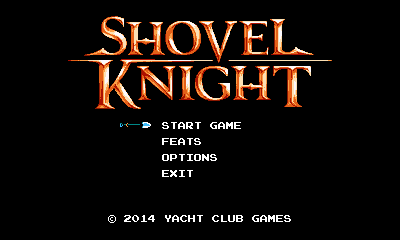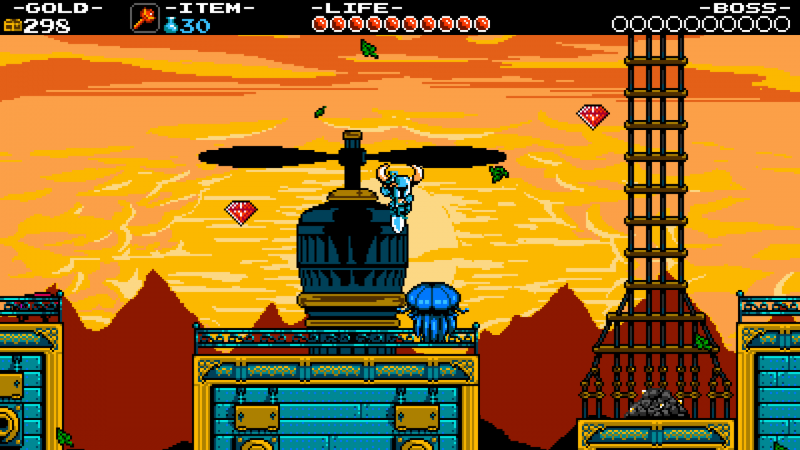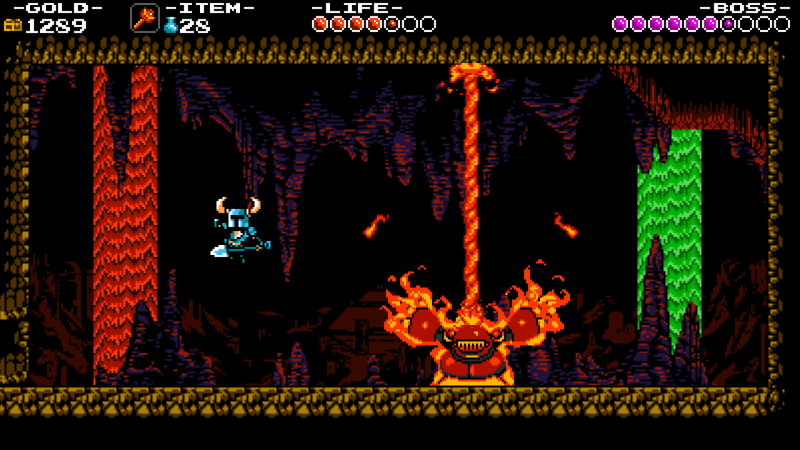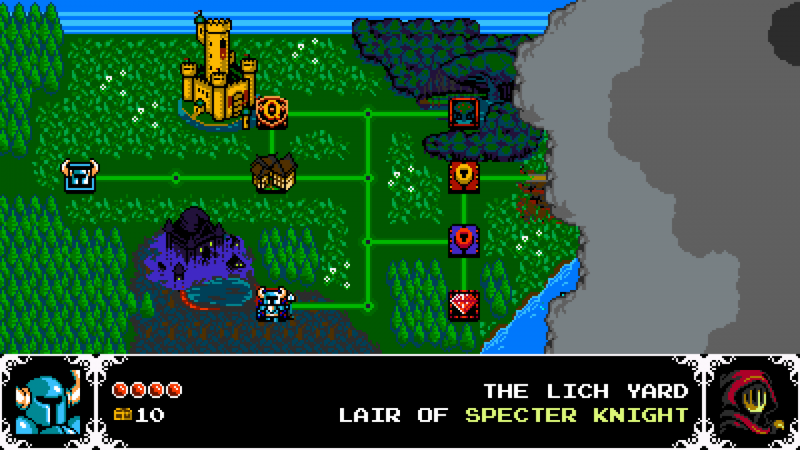 Games based around reliving the glorious days of eight-bit sprites and limited graphical fidelity seem to be a dime a dozen these days, thanks to the potency of the ever-growing indie market. Shovel Knight at first appears to be just another one of these titles, looking to score your money based on its nostalgic appeal. After only just the first few stages, I realized that Shovel Knight was onto something truly great. It wasn’t just another clone of Nintendo Entertainment System (NES) games, but it instead uses those games for inspiration to create something of its own.
Games based around reliving the glorious days of eight-bit sprites and limited graphical fidelity seem to be a dime a dozen these days, thanks to the potency of the ever-growing indie market. Shovel Knight at first appears to be just another one of these titles, looking to score your money based on its nostalgic appeal. After only just the first few stages, I realized that Shovel Knight was onto something truly great. It wasn’t just another clone of Nintendo Entertainment System (NES) games, but it instead uses those games for inspiration to create something of its own.
Shovel Knight is a 2D action-platformer where you traverse difficult worlds filled with dangerous enemies and perilous platforms to save your partner, Shield Knight. Your main weapon and tool is only a measly shovel. However, this shovel proves to be more useful than its paltry appearance. You can swipe at enemies horizontally to kill them or hop on top of them with a downward strike that also provides a boost in verticality. Initially, the first few levels are basic but vital in teaching you the different moves that the Shovel Knight character can perform, much how classic NES games taught you how to play without tutorials.

Shovel Knight reminds us how, despite the limitations of the NES, the sprite art still looks beautiful.
Quickly thereafter, the difficulty starts to increase steadily. Each new level presents new challenges and maneuvers that are required to survive and progress. Along with your traditional shovel, sub-weapons can be discovered to help provide some different attacks. If there’s an enemy above you that you can’t quite reach, the pickaxe sub-weapon will help because it is thrown in a high arc. When these levels start to open up and new sub-weapons are found, this flexibility expands your options of how to attack a situation. Do I expend my magic meter to use sub-weapons to take out this strong enemy, or do I risk my life total by going at it with just my shovel to preserve my magic meter? These types of choices in going about the levels make Shovel Knight truly enjoyable.
At the end of each level, there is a boss that is sure to test your skill. More often than not, your first attempt at a boss proves fruitless. However, the deaths aren’t necessarily a setback as you learn valuable information like a boss’s attack pattern and ways to capitalize based on their movements. The boss fights are downright fun, and in many ways, most traditional NES games’ bosses weren’t.

Bosses become increasingly more dangerous, requiring precise timing of attacks and the right sub-weapon.
A large part of Shovel Knight is collecting gold. Littered throughout the levels are oodles of gems to collect that can then be used to buy power-ups at the town like increased health, magic and new sub-weapons. Of course, the more rewarding chests and piles of loot are in secret areas that require you to use your wits as well as precise maneuvers to access. However, dying comes at a cost. Similar to the Dark Souls series, a portion of your gold is dropped wherever you died in a level. Die before you get to it, and that gold is lost. The problem is that gold is so abundant in every part of Shovel Knight that very rarely does it matter if you die and happen to lose gold. There wasn’t ever a time that I died and was worried about my gold total.
My biggest complaint with Shovel Knight is that it’s just way too short. I understand the desire to create a bona fide classic NES-style game, but having a small number of levels is a bit disappointing. It feels like there is just so much more that could’ve been done to expand upon the brilliant foundation laid out in Shovel Knight, but the obsession to create a game limited by the NES structure halts the fun sooner than I’d like. Sure, there’s a New Game+ option, but it only increases the amount of damage dealt from enemies and makes shorter checkpoints. It doesn’t necessarily add to the game mechanics other than having to play just a bit safer. By the time you get to New Game+, you have almost all of the power-ups, so gold becomes essentially meaningless.

The world is full of difficult, optional areas and roaming mini-bosses, just like Super Mario Bros. 3.
I won’t beat around the bush, though. Shovel Knight clearly takes ideas and mechanics from NES games. The aforementioned downward strike is straight from DuckTales, the sub-weapons are from Castlevania, the towns are from Zelda II: The Adventures of Link and the overworld map is from Super Mario Bros. 3. Even though Shovel Knight steals these mechanics, it utilizes the technology we have now to polish them and mold them together into something original. All of these mechanics and ideas are meshed so well with another that Shovel Knight feels like its own entity. To really hammer this home, Shovel Knight features some of the most beautiful sprite art I’ve seen in a game, with an incredible and upbeat soundtrack that fits the pace of the game.
Shovel Knight is a special game. Even if you never grew up playing NES games or experienced that era, there is still a lot to love. For hard-core gamers who did play those games, it’s hard to deny the power of nostalgia in Shovel Knight. When first starting, it’s hard not to grin from ear to ear as the Shovel Knight theme song plays and the classic cinematics go by. Shovel Knight isn’t just a grab of nostalgia for a quick buck, but it is instead a game that respects and redefines the era of NES games into its own unique work of art.
Shovel Knight is available for the Nintendo Wii U, Nintendo 3DS and PCs.
